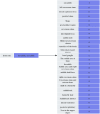Establishment of a risk prediction model for olfactory disorders in patients with transnasal pituitary tumors by machine learning
- PMID: 38822064
- PMCID: PMC11143333
- DOI: 10.1038/s41598-024-62963-7
Establishment of a risk prediction model for olfactory disorders in patients with transnasal pituitary tumors by machine learning
Abstract
To construct a prediction model of olfactory dysfunction after transnasal sellar pituitary tumor resection based on machine learning algorithms. A cross-sectional study was conducted. From January to December 2022, 158 patients underwent transnasal sellar pituitary tumor resection in three tertiary hospitals in Sichuan Province were selected as the research objects. The olfactory status was evaluated one week after surgery. They were randomly divided into a training set and a test set according to the ratio of 8:2. The training set was used to construct the prediction model, and the test set was used to evaluate the effect of the model. Based on different machine learning algorithms, BP neural network, logistic regression, decision tree, support vector machine, random forest, LightGBM, XGBoost, and AdaBoost were established to construct olfactory dysfunction risk prediction models. The accuracy, precision, recall, F1 score, and area under the ROC curve (AUC) were used to evaluate the model's prediction performance, the optimal prediction model algorithm was selected, and the model was verified in the test set of patients. Of the 158 patients, 116 (73.42%) had postoperative olfactory dysfunction. After missing value processing and feature screening, an essential order of influencing factors of olfactory dysfunction was obtained. Among them, the duration of operation, gender, type of pituitary tumor, pituitary tumor apoplexy, nasal adhesion, age, cerebrospinal fluid leakage, blood scar formation, and smoking history became the risk factors of olfactory dysfunction, which were the key indicators of the construction of the model. Among them, the random forest model had the highest AUC of 0.846, and the accuracy, precision, recall, and F1 score were 0.750, 0.870, 0.947, and 0.833, respectively. Compared with the BP neural network, logistic regression, decision tree, support vector machine, LightGBM, XGBoost, and AdaBoost, the random forest model has more advantages in predicting olfactory dysfunction in patients after transnasal sellar pituitary tumor resection, which is helpful for early identification and intervention of high-risk clinical population, and has good clinical application prospects.
Keywords: Machine learning; Olfactory impairment; Pituitary tumor; Predictive models; Transnasal pterygoid region.
© 2024. The Author(s).
Conflict of interest statement
The authors declare no competing interests.
Figures







Similar articles
-
Development of machine learning models to predict the risk of fungal infection following flexible ureteroscopy lithotripsy.BMC Med Inform Decis Mak. 2025 Apr 10;25(1):159. doi: 10.1186/s12911-025-02987-9. BMC Med Inform Decis Mak. 2025. PMID: 40211277 Free PMC article.
-
Machine learning algorithms for predicting delayed hyponatremia after transsphenoidal surgery for patients with pituitary adenoma.Sci Rep. 2025 Jan 9;15(1):1463. doi: 10.1038/s41598-024-83319-1. Sci Rep. 2025. PMID: 39789007 Free PMC article.
-
Establishment and validation of a heart failure risk prediction model for elderly patients after coronary rotational atherectomy based on machine learning.PeerJ. 2024 Jan 31;12:e16867. doi: 10.7717/peerj.16867. eCollection 2024. PeerJ. 2024. PMID: 38313005 Free PMC article. Clinical Trial.
-
Prediction and Evaluation of Machine Learning Algorithm for Prediction of Blood Transfusion during Cesarean Section and Analysis of Risk Factors of Hypothermia during Anesthesia Recovery.Comput Math Methods Med. 2022 Apr 13;2022:8661324. doi: 10.1155/2022/8661324. eCollection 2022. Comput Math Methods Med. 2022. Retraction in: Comput Math Methods Med. 2023 Jun 28;2023:9863486. doi: 10.1155/2023/9863486. PMID: 35465016 Free PMC article. Retracted.
-
Integrating genetics, metabolites, and clinical characteristics in predicting cardiometabolic health outcomes using machine learning algorithms - A systematic review.Comput Biol Med. 2025 Mar;186:109661. doi: 10.1016/j.compbiomed.2025.109661. Epub 2025 Jan 11. Comput Biol Med. 2025. PMID: 39799831
Cited by
-
Preoperative prediction of the selection of the NOTES approach for patients with symptomatic simple renal cysts via an interpretable machine learning model: a retrospective study of 264 patients.Langenbecks Arch Surg. 2025 Jan 4;410(1):22. doi: 10.1007/s00423-024-03586-4. Langenbecks Arch Surg. 2025. PMID: 39753974
References
MeSH terms
Grants and funding
LinkOut - more resources
Full Text Sources
Medical

